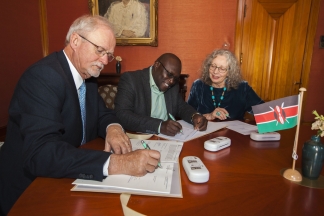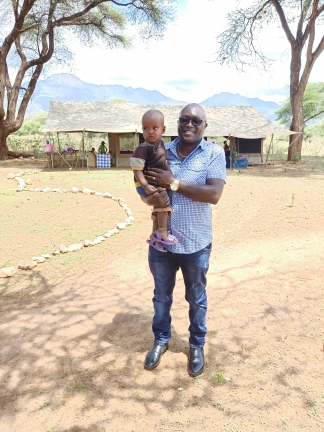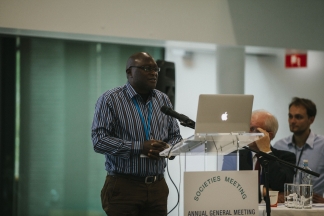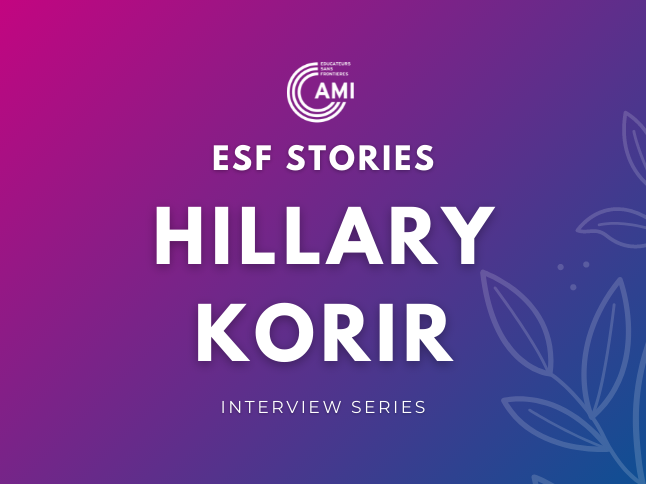Hillary Korir has been engaged in Montessori work in Kenya for over 10 years. He was involved in the establishment and development of the Corner of Hope initiative, and became the first executive director of Montessori for Kenya (MfK). Hillary is now taking up a new responsibility at the Kenyan government, but will stay closely involved with MfK. We would like to thank Hillary for all his efforts and his valuable contributions to the growth of Montessori in Kenya.

Hillary, where in the world did you grow up?
I grew up in a place called Kapsabet, in the Rift Valley province of Kenya. It is considered an evergreen area; plenty of rainfall throughout the year with plenty of crops growing, especially tea. It is a very fertile area.
Can you describe one of your most precious childhood memories?
I remember this one event that I looked forward to every year, together with my siblings. There was an agricultural exhibition, or a trade fair, that was held annually within my own town. I remember we would be at home, eagerly waiting for a car to come and pick us and take us to these large exhibitions. We would see a variety of crops, people displaying various wares and products, and there were even quite a number of animals on display. One key interest that I had as a child was to see the wild animal stand. This memory is still imprinted in my mind, and I always look forward to such an event.
Did one person inspire you specifically during your childhood.
My mom was my biggest inspiration. I remember when I went to nursery school, she was always encouraging me to go to school, to work hard, to be kind to others and treat others as equals. My mom was the one who always encouraged us to go to school. Everybody in the family has gone to school and progressed in their education, and we are grateful to our mom for always encouraging us.
Can you please tell us a little bit about the work or the initiative you are engaged in?
For the last 10 years I have been involved in managing development work. First as the Caritas director at the Diocese of Nakuru, charged with the responsibility of coordinating development projects such as pastoral and community development. Later on I became involved in Montessori work. Until recently, I was the executive director of Montessori for Kenya, an NGO founded in 2019 with a mandate to advance the spread of quality Montessori education and infrastructure in Kenya. I have also been the project manager of Corner of Hope, which included the Corner of Hope schools in Nakuru but also many other initiatives in different parts of the country that have developed inspired by Corner of Hope.

What inspired you to be to become involved in these initiatives?
My work with these initiatives started after the post-election violence that happened in the year 2007/ 2008. Back then, I was working as the Director of Development within Nakuru and every election period there was violence. During 2007/2008, the magnitude of the violence was very big. It led to the establishment of Internally Displaced Persons (IDP) camps. Lynne Lawrence visited the country at the invitation of the late Sister Angela – the principal of St. Ann’s Montessori Teachers College – because of the previous Montessori work she had done within Kenya and Tanzania. During Lynne’s visit, Sister Angela shared that she felt bad because there were quite a number of children within the IDP camp that were not being attended to.
They visited the camp and plans started to evolve through discussions with AMI. I was in charge of coordinating projects in the region, and I was involved in discussing the ideas and writing the proposal. Eventually the initiative became reality. We established Corner of Hope, recruited teachers who went for Montessori training and enhanced partnerships with other actors. Over time, teachers were trained, the school building was built, the school expanded and children were welcomed in, leading to the establishment of other schools. Later on, Montessori for Kenya was established, because the scope of the work was increasing in Kenya.
I think the inspiration for me to join in all these initiatives was, first of all, the Montessori methodology that was being introduced. At first there was apprehension from within the community in terms of the uptake of this new methodology. But when the community started embracing it, you could see a change immediately. The teachers were recruited from within the community and they were guiding the children with the assistance of mentor teachers. Later on, you could see the change in the children also affecting the parents of the community. Montessori was bringing change within the entire community. I was very inspired by this. It was influencing the life of many within the community, beyond just the children themselves. The parents, who came to accept that this was a really good methodology for them, aspired to bring their children to study in the Corner of Hope School. Since then I began being involved in the promotion of Montessori in Kenya, from Corner of Hope, to Kisima, to Samburu and many other initiatives that are still evolving.
What do you see as the most essential part of your work?
I think one of the most essential parts of what I did is the aspect of giving children the opportunity to pursue the best education, which for me is Montessori education, and especially for the less privileged within this society. For a long period of time, I have found people saying Montessori education is for people with a lot of money, but we have been able to bring it to an under-resourced context, and it has worked well. I think that is the most essential part, that you are not taking it to those who already have but that you demonstrate that also less privileged communities in terms of financial means, like the formerly displaced children, the children of the under-resourced Pokot community and the Samburu, are already accessing the same quality education.

We have trained many teachers through scholarships. When you look at the community, there are over 100 teachers who have been trained, earning a livelihood through their certificate training. Others are pursuing an international diploma. There is the capacity for development and at the same time, a life transformation for many. And not to forget, giving children an opportunity to pursue Montessori education means, in my opinion, a great transformation for these children.

What are your dreams for the future?
Up to now I have been the executive director of Montessori for Kenya, but now I’m shifting to another role within the organisation. My dream for the future, and this is something I’ve always dreamt, is first of all to see Montessori for Kenya growing into a valued organisation that is able to service the Montessori needs that come up within the country and beyond. I would also like to see a situation where Montessori education is being embraced by many schools, so that the method can be practiced in different parts of the country. The Competency Based Curriculum (CBC) that the Kenyan government introduced is largely borrowed from the Montessori curriculum, and it is being accepted. CBC teachers ask Montessori trained teachers to assist them to understand the methodology. It will be a big step to get to a situation in which Montessori teachers in different parts of the country are being appreciated,
valued and entered into the system.
My personal dream is to establish a fully-fledged Montessori school which can showcase real Montessori practice from early childhood level up to secondary education. Establishing such a place is my great dream for the future.

